Detailed Business Environment Analysis Report for Nestle
VerifiedAdded on 2020/11/23
|12
|3174
|306
Report
AI Summary
This report offers a comprehensive analysis of Nestle's business environment. It begins with an introduction to the concept of the business environment, encompassing both internal and external factors impacting organizational operations. The report then delves into the organizational structure of Nestle, highlighting the interrelationship between various departments such as marketing, finance, R&D, human resources, and production, and their alignment with the company's objectives. A PESTLE analysis is conducted to evaluate the political, economic, social, technological, legal, and environmental factors affecting Nestle. Furthermore, a SWOT analysis is presented to assess the company's strengths, weaknesses, opportunities, and threats. The interrelation of strengths and weaknesses with external macro factors is also explored, providing a holistic view of Nestle's strategic position. The report utilizes sources such as Cassell and Blake (2012), Cavalcante et al. (2011), Cronan et al. (2011), Elliot (2011), Hall (2011), Palo and Tähtinen-Saleem (2017), Kaufmann et al. (2011), Lee et al. (2012), and Owusuand and Habiyakare (2011) to support its findings.

Business Environment
Paraphrase This Document
Need a fresh take? Get an instant paraphrase of this document with our AI Paraphraser

Table of Contents
INTRODUCTION...........................................................................................................................1
TASK 1............................................................................................................................................1
Covered in PPT.......................................................................................................................1
TASK 2 ...........................................................................................................................................1
P3. Relationship between various organisational functions and their link with structure and
objectives of organisation.......................................................................................................1
TASK 3............................................................................................................................................3
P4 PESTLE analysis of Nestle...............................................................................................3
TASK 4............................................................................................................................................5
P5 SWOT analysis of Nestle..................................................................................................5
P6: Interrelation of strengths and weaknesses with external macro factors...........................6
CONCLUSION................................................................................................................................7
REFERENCES................................................................................................................................8
.........................................................................................................................................................9
INTRODUCTION...........................................................................................................................1
TASK 1............................................................................................................................................1
Covered in PPT.......................................................................................................................1
TASK 2 ...........................................................................................................................................1
P3. Relationship between various organisational functions and their link with structure and
objectives of organisation.......................................................................................................1
TASK 3............................................................................................................................................3
P4 PESTLE analysis of Nestle...............................................................................................3
TASK 4............................................................................................................................................5
P5 SWOT analysis of Nestle..................................................................................................5
P6: Interrelation of strengths and weaknesses with external macro factors...........................6
CONCLUSION................................................................................................................................7
REFERENCES................................................................................................................................8
.........................................................................................................................................................9

⊘ This is a preview!⊘
Do you want full access?
Subscribe today to unlock all pages.

Trusted by 1+ million students worldwide
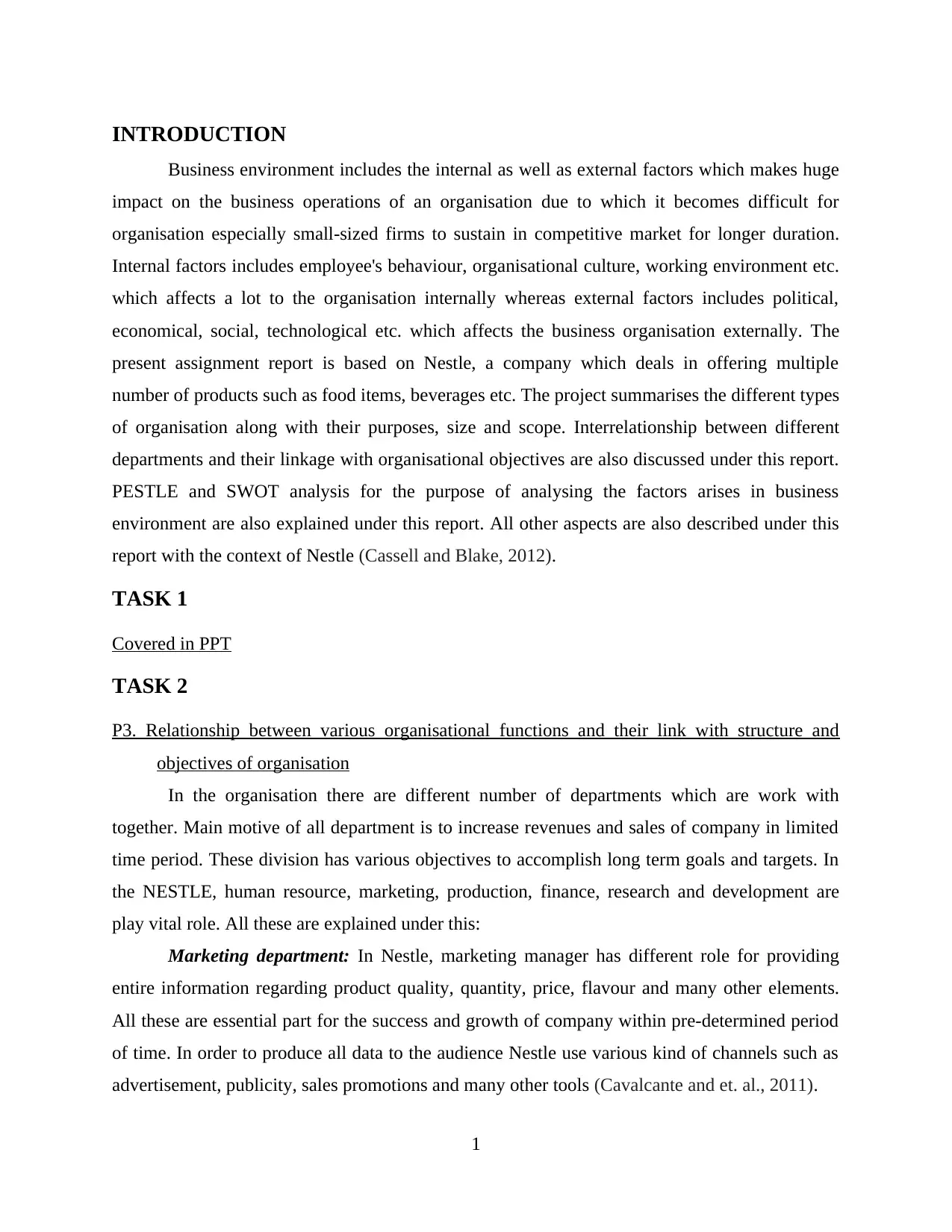
INTRODUCTION
Business environment includes the internal as well as external factors which makes huge
impact on the business operations of an organisation due to which it becomes difficult for
organisation especially small-sized firms to sustain in competitive market for longer duration.
Internal factors includes employee's behaviour, organisational culture, working environment etc.
which affects a lot to the organisation internally whereas external factors includes political,
economical, social, technological etc. which affects the business organisation externally. The
present assignment report is based on Nestle, a company which deals in offering multiple
number of products such as food items, beverages etc. The project summarises the different types
of organisation along with their purposes, size and scope. Interrelationship between different
departments and their linkage with organisational objectives are also discussed under this report.
PESTLE and SWOT analysis for the purpose of analysing the factors arises in business
environment are also explained under this report. All other aspects are also described under this
report with the context of Nestle (Cassell and Blake, 2012).
TASK 1
Covered in PPT
TASK 2
P3. Relationship between various organisational functions and their link with structure and
objectives of organisation
In the organisation there are different number of departments which are work with
together. Main motive of all department is to increase revenues and sales of company in limited
time period. These division has various objectives to accomplish long term goals and targets. In
the NESTLE, human resource, marketing, production, finance, research and development are
play vital role. All these are explained under this:
Marketing department: In Nestle, marketing manager has different role for providing
entire information regarding product quality, quantity, price, flavour and many other elements.
All these are essential part for the success and growth of company within pre-determined period
of time. In order to produce all data to the audience Nestle use various kind of channels such as
advertisement, publicity, sales promotions and many other tools (Cavalcante and et. al., 2011).
1
Business environment includes the internal as well as external factors which makes huge
impact on the business operations of an organisation due to which it becomes difficult for
organisation especially small-sized firms to sustain in competitive market for longer duration.
Internal factors includes employee's behaviour, organisational culture, working environment etc.
which affects a lot to the organisation internally whereas external factors includes political,
economical, social, technological etc. which affects the business organisation externally. The
present assignment report is based on Nestle, a company which deals in offering multiple
number of products such as food items, beverages etc. The project summarises the different types
of organisation along with their purposes, size and scope. Interrelationship between different
departments and their linkage with organisational objectives are also discussed under this report.
PESTLE and SWOT analysis for the purpose of analysing the factors arises in business
environment are also explained under this report. All other aspects are also described under this
report with the context of Nestle (Cassell and Blake, 2012).
TASK 1
Covered in PPT
TASK 2
P3. Relationship between various organisational functions and their link with structure and
objectives of organisation
In the organisation there are different number of departments which are work with
together. Main motive of all department is to increase revenues and sales of company in limited
time period. These division has various objectives to accomplish long term goals and targets. In
the NESTLE, human resource, marketing, production, finance, research and development are
play vital role. All these are explained under this:
Marketing department: In Nestle, marketing manager has different role for providing
entire information regarding product quality, quantity, price, flavour and many other elements.
All these are essential part for the success and growth of company within pre-determined period
of time. In order to produce all data to the audience Nestle use various kind of channels such as
advertisement, publicity, sales promotions and many other tools (Cavalcante and et. al., 2011).
1
Paraphrase This Document
Need a fresh take? Get an instant paraphrase of this document with our AI Paraphraser

Finance department: Under this, different departments are play vital role in the success
and growth of company. In this main responsibility of finance manager is to arrange accurate
amount of fund. It is important for the company to do their all activities and functions easily.
There are different sources from which funds can raised such as financial institutions like banks,
venture capital, owner's capital etc. It ill increases the financial position of company due to
which the company can adopt advanced and updated technology in their business structure.
Thus, it support the company to achieve their long term objectives and targets in certain time
duration.
R&D department: Nestle is one of the world's best and well-established organisation in
all over the globe. In this research and development department has various role for organising
effective research which help the business to easily identify needs and desired of customers
about Nestle products. Therefore, they are understood and aware about the clients requirement
they provide better quality in the products as well as services also.
Human resource: It is another department in the Nestle which has various roles for
providing training and development, incentives, reward management, performance appraisal and
many other benefits to the employees. Thus, they arrange an effective training program which
support them to increase productivity and performance level of workers systematically.
Therefore, HR department mainly focuses on meeting human resource requirements in an
organisation and recruit accordingly in order to get adequate support from them in achieving
desired goals and objectives. Therefore, they are trained and has motive to maximise sales and
revenues of the firm.
Production: Main role of production manager is to manufacture better quality in their
products and services. It assist the business to increase their turnover. They are important part for
the business development and success. Nestle serve innovative and high quality goods to its
target and potential clients which help in retaining them for longer period of time. For this, it is
essential for production team to utilise available resources in an optimum manner. In this all
audience are satisfied with Nestle new and added flavour products (Cronan and et. al., 2011).
Organisation Structure:
Product based: It is formed by the company as per its quality goods and beverages which
are demanded more in marketplace. In which role of manager is to provide quality goods as per
the needs of customers.
2
and growth of company. In this main responsibility of finance manager is to arrange accurate
amount of fund. It is important for the company to do their all activities and functions easily.
There are different sources from which funds can raised such as financial institutions like banks,
venture capital, owner's capital etc. It ill increases the financial position of company due to
which the company can adopt advanced and updated technology in their business structure.
Thus, it support the company to achieve their long term objectives and targets in certain time
duration.
R&D department: Nestle is one of the world's best and well-established organisation in
all over the globe. In this research and development department has various role for organising
effective research which help the business to easily identify needs and desired of customers
about Nestle products. Therefore, they are understood and aware about the clients requirement
they provide better quality in the products as well as services also.
Human resource: It is another department in the Nestle which has various roles for
providing training and development, incentives, reward management, performance appraisal and
many other benefits to the employees. Thus, they arrange an effective training program which
support them to increase productivity and performance level of workers systematically.
Therefore, HR department mainly focuses on meeting human resource requirements in an
organisation and recruit accordingly in order to get adequate support from them in achieving
desired goals and objectives. Therefore, they are trained and has motive to maximise sales and
revenues of the firm.
Production: Main role of production manager is to manufacture better quality in their
products and services. It assist the business to increase their turnover. They are important part for
the business development and success. Nestle serve innovative and high quality goods to its
target and potential clients which help in retaining them for longer period of time. For this, it is
essential for production team to utilise available resources in an optimum manner. In this all
audience are satisfied with Nestle new and added flavour products (Cronan and et. al., 2011).
Organisation Structure:
Product based: It is formed by the company as per its quality goods and beverages which
are demanded more in marketplace. In which role of manager is to provide quality goods as per
the needs of customers.
2

Consumer based: This type of structure is formed as per the preferences and behaviour
of audience in order to satisfy them through rendering healthy products and services.
Geography based: It is formed by the Nestle manager as per the different locations that
acquire more bunch for Nestle services and products.
Function based: This structure is framed by the Nestle manager with the help of different
departments such as marketing, finance, R&D, HR and many.
TASK 3
P4 PESTLE analysis of Nestle
Every organization is effected by the different factors that represent inside and outside the
business surroundings. It is important that timely evaluating of every factor is done so that it can
be analyzed that how they impact the functioning of business as some has their positive effect
and other has negative impact upon the business. In order to understand how Nestle is effected
by the factors that are present outside the enterprise pestle analysis of same is conducted which
will help in knowing the extent to which it is affected.
Political factors – It is an effect of political conditions that are prevailing in the market as
every country has their own power body at center who regulates the function of business. It has
indirect impact over the functioning of business as it restricts the capacity of an enterprise to
grow. The effects of this change has its both beneficial and non-beneficial effects on business
which are as follows:
Positive effect
Less restrictions shown by different countries for allowing Nestle to expand its business at
a global level (Elliot, 2011).
Negative effect
Continuous change in the present laws and regulations which makes it difficult for the
referred enterprise to adopt and maintain the required level of profit margins.
Instability in the emerging economies raises question of risk as part of the international
process.
Environmental factors – These are the factors that are associated with the protection of
surrounding against any harm that may create due to the unhealthy practice of an enterprise.
Positive Factor
3
of audience in order to satisfy them through rendering healthy products and services.
Geography based: It is formed by the Nestle manager as per the different locations that
acquire more bunch for Nestle services and products.
Function based: This structure is framed by the Nestle manager with the help of different
departments such as marketing, finance, R&D, HR and many.
TASK 3
P4 PESTLE analysis of Nestle
Every organization is effected by the different factors that represent inside and outside the
business surroundings. It is important that timely evaluating of every factor is done so that it can
be analyzed that how they impact the functioning of business as some has their positive effect
and other has negative impact upon the business. In order to understand how Nestle is effected
by the factors that are present outside the enterprise pestle analysis of same is conducted which
will help in knowing the extent to which it is affected.
Political factors – It is an effect of political conditions that are prevailing in the market as
every country has their own power body at center who regulates the function of business. It has
indirect impact over the functioning of business as it restricts the capacity of an enterprise to
grow. The effects of this change has its both beneficial and non-beneficial effects on business
which are as follows:
Positive effect
Less restrictions shown by different countries for allowing Nestle to expand its business at
a global level (Elliot, 2011).
Negative effect
Continuous change in the present laws and regulations which makes it difficult for the
referred enterprise to adopt and maintain the required level of profit margins.
Instability in the emerging economies raises question of risk as part of the international
process.
Environmental factors – These are the factors that are associated with the protection of
surrounding against any harm that may create due to the unhealthy practice of an enterprise.
Positive Factor
3
⊘ This is a preview!⊘
Do you want full access?
Subscribe today to unlock all pages.

Trusted by 1+ million students worldwide
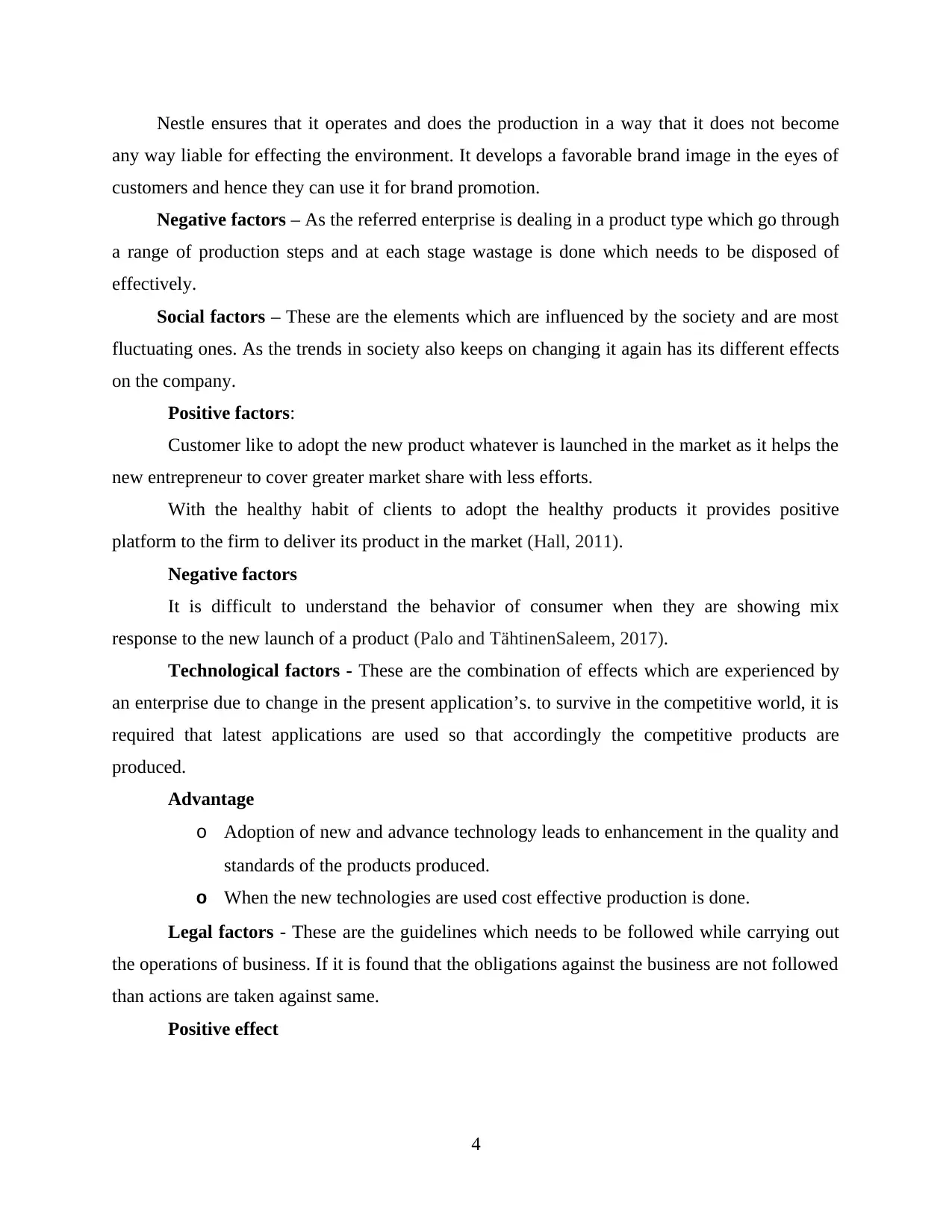
Nestle ensures that it operates and does the production in a way that it does not become
any way liable for effecting the environment. It develops a favorable brand image in the eyes of
customers and hence they can use it for brand promotion.
Negative factors – As the referred enterprise is dealing in a product type which go through
a range of production steps and at each stage wastage is done which needs to be disposed of
effectively.
Social factors – These are the elements which are influenced by the society and are most
fluctuating ones. As the trends in society also keeps on changing it again has its different effects
on the company.
Positive factors:
Customer like to adopt the new product whatever is launched in the market as it helps the
new entrepreneur to cover greater market share with less efforts.
With the healthy habit of clients to adopt the healthy products it provides positive
platform to the firm to deliver its product in the market (Hall, 2011).
Negative factors
It is difficult to understand the behavior of consumer when they are showing mix
response to the new launch of a product (Palo and TähtinenSaleem, 2017).
Technological factors - These are the combination of effects which are experienced by
an enterprise due to change in the present application’s. to survive in the competitive world, it is
required that latest applications are used so that accordingly the competitive products are
produced.
Advantage
o Adoption of new and advance technology leads to enhancement in the quality and
standards of the products produced.
o When the new technologies are used cost effective production is done.
Legal factors - These are the guidelines which needs to be followed while carrying out
the operations of business. If it is found that the obligations against the business are not followed
than actions are taken against same.
Positive effect
4
any way liable for effecting the environment. It develops a favorable brand image in the eyes of
customers and hence they can use it for brand promotion.
Negative factors – As the referred enterprise is dealing in a product type which go through
a range of production steps and at each stage wastage is done which needs to be disposed of
effectively.
Social factors – These are the elements which are influenced by the society and are most
fluctuating ones. As the trends in society also keeps on changing it again has its different effects
on the company.
Positive factors:
Customer like to adopt the new product whatever is launched in the market as it helps the
new entrepreneur to cover greater market share with less efforts.
With the healthy habit of clients to adopt the healthy products it provides positive
platform to the firm to deliver its product in the market (Hall, 2011).
Negative factors
It is difficult to understand the behavior of consumer when they are showing mix
response to the new launch of a product (Palo and TähtinenSaleem, 2017).
Technological factors - These are the combination of effects which are experienced by
an enterprise due to change in the present application’s. to survive in the competitive world, it is
required that latest applications are used so that accordingly the competitive products are
produced.
Advantage
o Adoption of new and advance technology leads to enhancement in the quality and
standards of the products produced.
o When the new technologies are used cost effective production is done.
Legal factors - These are the guidelines which needs to be followed while carrying out
the operations of business. If it is found that the obligations against the business are not followed
than actions are taken against same.
Positive effect
4
Paraphrase This Document
Need a fresh take? Get an instant paraphrase of this document with our AI Paraphraser

It helps in establishing a clear image of the enterprise as by following the legal
aspects of business an organization can establish its code of conduct which will be according to
laws (Kaufmann and et. al., 2011).
Negative effect
According to the laws nestle is bound to follow the health and safety laws which
are very much complex and raises the work pressure on management.
TASK 4
P5 SWOT analysis of Nestle
Apart from the external factors there are range of other elements too which has their direct
effect on the functioning of business and these are present within the business surroundings. By
taking corrective measures on time the impact of same can be minimized and hence better results
can be achieved. Swot analysis of same is done below in order to recognize the strength and
weaknesses of nestle:
Strength – Nestle is one of the leading brand in its industry which is dealing in
diversified and global products portfolio. The research and development team of the refereed
enterprise is effective enough which helps it in achieving its targets.
Weaknesses – The refereed brand has to compromise with the profit margins as when it
operates at global level as foreign exchange swings cuts into profit. Apart from this it also
experiences low returns in market like UK where post – brexit factors are present. There was a
time when the referred firm image was effected by the other brand for carrying out the child
labor which effected the sales too in the long run.
Threat – the supply chain of the refereed enterprise is effected by the Brexit which has a
great impact on the mobility of labor. Thereafter the laws related to sugar kept on changing in the
market like UK which further acted as a threat for the referred institution (Lee and et. al., 2012).
Opportunity – There are chances of growth in the low calorie beverages which ca help
Nestle to promote total sales and make a healthy brand image in the market. Apart from this it
can also grow by adding more product variety to its products as customer like options and get
higher satisfaction when are given choices. It further promotes the brand value too and assist in
achieving the competitive advantage.
5
aspects of business an organization can establish its code of conduct which will be according to
laws (Kaufmann and et. al., 2011).
Negative effect
According to the laws nestle is bound to follow the health and safety laws which
are very much complex and raises the work pressure on management.
TASK 4
P5 SWOT analysis of Nestle
Apart from the external factors there are range of other elements too which has their direct
effect on the functioning of business and these are present within the business surroundings. By
taking corrective measures on time the impact of same can be minimized and hence better results
can be achieved. Swot analysis of same is done below in order to recognize the strength and
weaknesses of nestle:
Strength – Nestle is one of the leading brand in its industry which is dealing in
diversified and global products portfolio. The research and development team of the refereed
enterprise is effective enough which helps it in achieving its targets.
Weaknesses – The refereed brand has to compromise with the profit margins as when it
operates at global level as foreign exchange swings cuts into profit. Apart from this it also
experiences low returns in market like UK where post – brexit factors are present. There was a
time when the referred firm image was effected by the other brand for carrying out the child
labor which effected the sales too in the long run.
Threat – the supply chain of the refereed enterprise is effected by the Brexit which has a
great impact on the mobility of labor. Thereafter the laws related to sugar kept on changing in the
market like UK which further acted as a threat for the referred institution (Lee and et. al., 2012).
Opportunity – There are chances of growth in the low calorie beverages which ca help
Nestle to promote total sales and make a healthy brand image in the market. Apart from this it
can also grow by adding more product variety to its products as customer like options and get
higher satisfaction when are given choices. It further promotes the brand value too and assist in
achieving the competitive advantage.
5
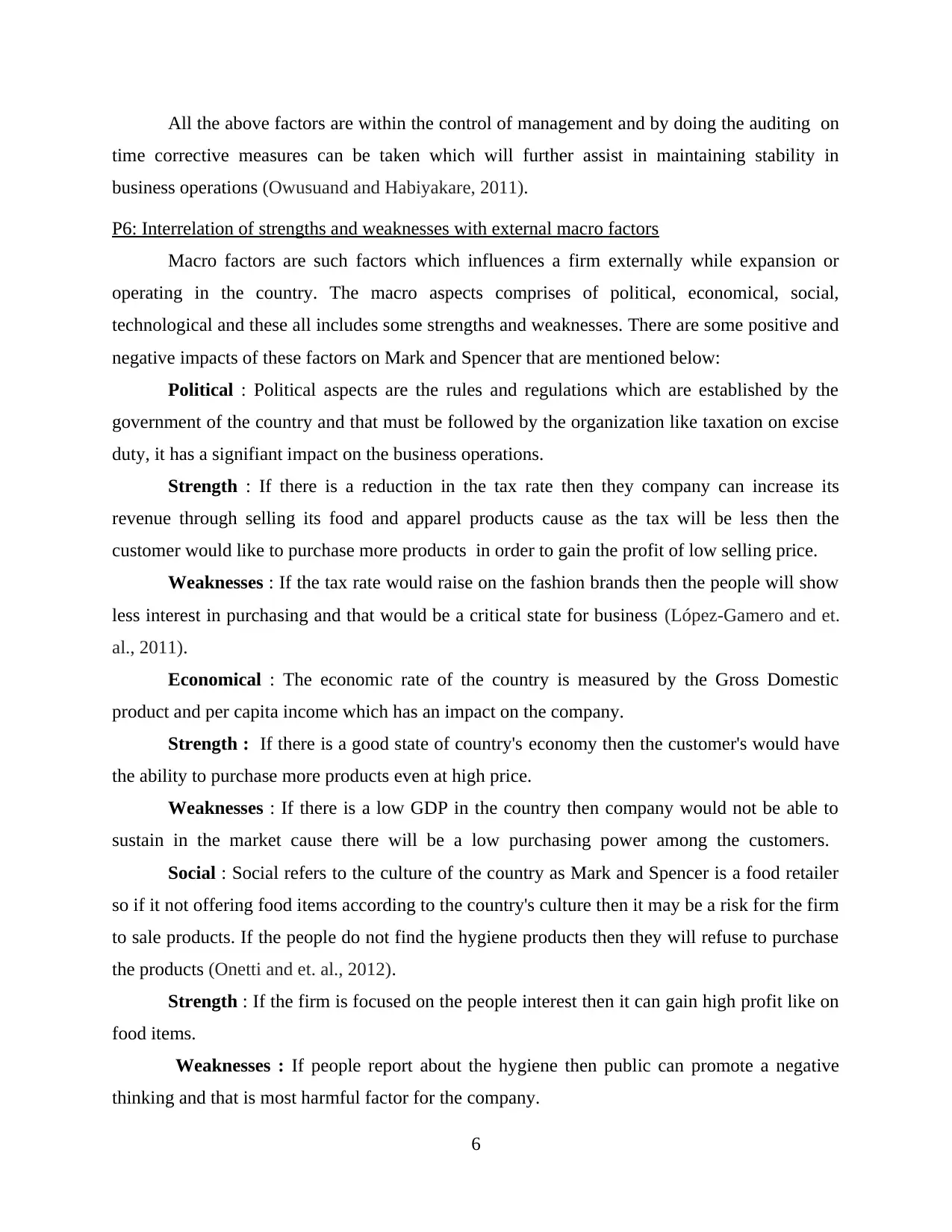
All the above factors are within the control of management and by doing the auditing on
time corrective measures can be taken which will further assist in maintaining stability in
business operations (Owusuand and Habiyakare, 2011).
P6: Interrelation of strengths and weaknesses with external macro factors
Macro factors are such factors which influences a firm externally while expansion or
operating in the country. The macro aspects comprises of political, economical, social,
technological and these all includes some strengths and weaknesses. There are some positive and
negative impacts of these factors on Mark and Spencer that are mentioned below:
Political : Political aspects are the rules and regulations which are established by the
government of the country and that must be followed by the organization like taxation on excise
duty, it has a signifiant impact on the business operations.
Strength : If there is a reduction in the tax rate then they company can increase its
revenue through selling its food and apparel products cause as the tax will be less then the
customer would like to purchase more products in order to gain the profit of low selling price.
Weaknesses : If the tax rate would raise on the fashion brands then the people will show
less interest in purchasing and that would be a critical state for business (López-Gamero and et.
al., 2011).
Economical : The economic rate of the country is measured by the Gross Domestic
product and per capita income which has an impact on the company.
Strength : If there is a good state of country's economy then the customer's would have
the ability to purchase more products even at high price.
Weaknesses : If there is a low GDP in the country then company would not be able to
sustain in the market cause there will be a low purchasing power among the customers.
Social : Social refers to the culture of the country as Mark and Spencer is a food retailer
so if it not offering food items according to the country's culture then it may be a risk for the firm
to sale products. If the people do not find the hygiene products then they will refuse to purchase
the products (Onetti and et. al., 2012).
Strength : If the firm is focused on the people interest then it can gain high profit like on
food items.
Weaknesses : If people report about the hygiene then public can promote a negative
thinking and that is most harmful factor for the company.
6
time corrective measures can be taken which will further assist in maintaining stability in
business operations (Owusuand and Habiyakare, 2011).
P6: Interrelation of strengths and weaknesses with external macro factors
Macro factors are such factors which influences a firm externally while expansion or
operating in the country. The macro aspects comprises of political, economical, social,
technological and these all includes some strengths and weaknesses. There are some positive and
negative impacts of these factors on Mark and Spencer that are mentioned below:
Political : Political aspects are the rules and regulations which are established by the
government of the country and that must be followed by the organization like taxation on excise
duty, it has a signifiant impact on the business operations.
Strength : If there is a reduction in the tax rate then they company can increase its
revenue through selling its food and apparel products cause as the tax will be less then the
customer would like to purchase more products in order to gain the profit of low selling price.
Weaknesses : If the tax rate would raise on the fashion brands then the people will show
less interest in purchasing and that would be a critical state for business (López-Gamero and et.
al., 2011).
Economical : The economic rate of the country is measured by the Gross Domestic
product and per capita income which has an impact on the company.
Strength : If there is a good state of country's economy then the customer's would have
the ability to purchase more products even at high price.
Weaknesses : If there is a low GDP in the country then company would not be able to
sustain in the market cause there will be a low purchasing power among the customers.
Social : Social refers to the culture of the country as Mark and Spencer is a food retailer
so if it not offering food items according to the country's culture then it may be a risk for the firm
to sale products. If the people do not find the hygiene products then they will refuse to purchase
the products (Onetti and et. al., 2012).
Strength : If the firm is focused on the people interest then it can gain high profit like on
food items.
Weaknesses : If people report about the hygiene then public can promote a negative
thinking and that is most harmful factor for the company.
6
⊘ This is a preview!⊘
Do you want full access?
Subscribe today to unlock all pages.

Trusted by 1+ million students worldwide
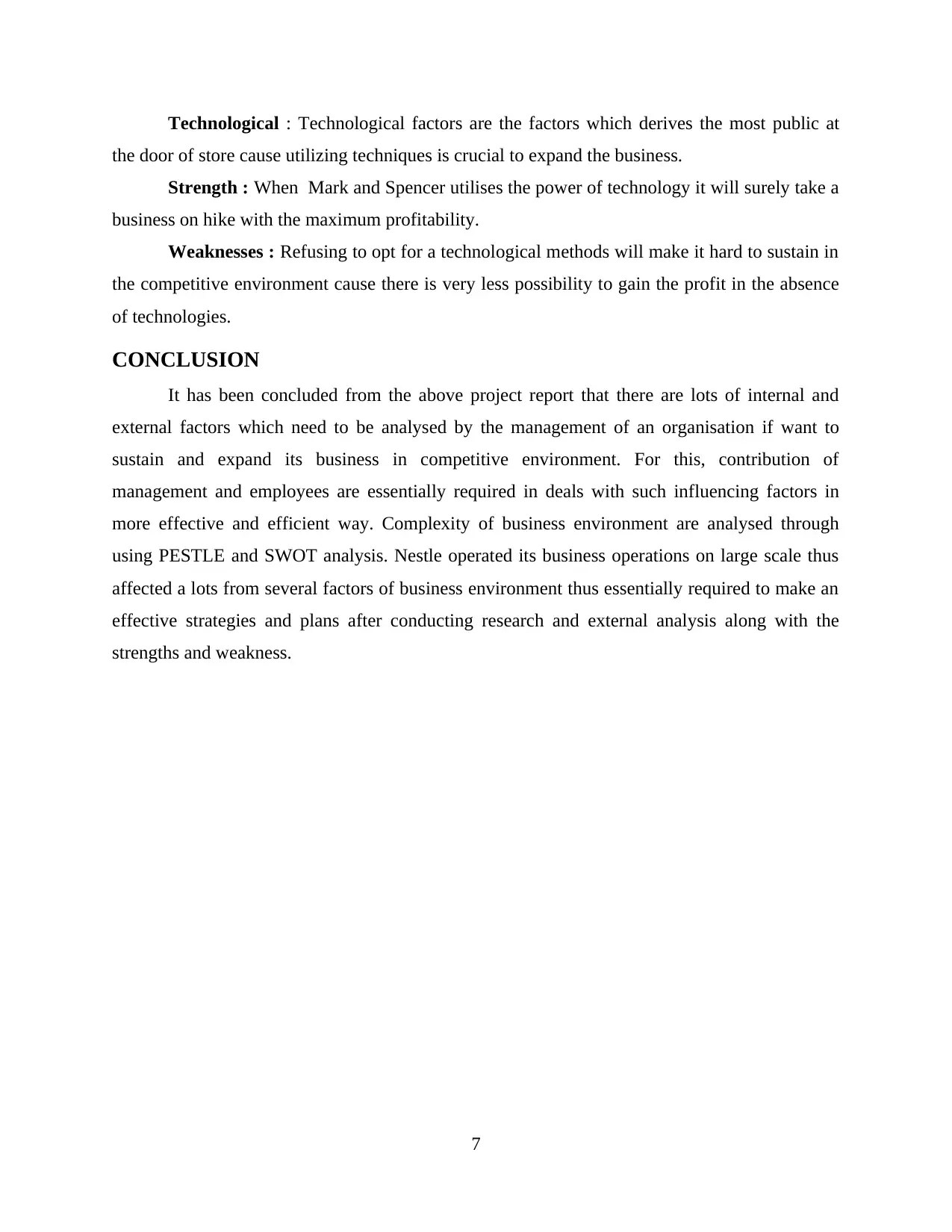
Technological : Technological factors are the factors which derives the most public at
the door of store cause utilizing techniques is crucial to expand the business.
Strength : When Mark and Spencer utilises the power of technology it will surely take a
business on hike with the maximum profitability.
Weaknesses : Refusing to opt for a technological methods will make it hard to sustain in
the competitive environment cause there is very less possibility to gain the profit in the absence
of technologies.
CONCLUSION
It has been concluded from the above project report that there are lots of internal and
external factors which need to be analysed by the management of an organisation if want to
sustain and expand its business in competitive environment. For this, contribution of
management and employees are essentially required in deals with such influencing factors in
more effective and efficient way. Complexity of business environment are analysed through
using PESTLE and SWOT analysis. Nestle operated its business operations on large scale thus
affected a lots from several factors of business environment thus essentially required to make an
effective strategies and plans after conducting research and external analysis along with the
strengths and weakness.
7
the door of store cause utilizing techniques is crucial to expand the business.
Strength : When Mark and Spencer utilises the power of technology it will surely take a
business on hike with the maximum profitability.
Weaknesses : Refusing to opt for a technological methods will make it hard to sustain in
the competitive environment cause there is very less possibility to gain the profit in the absence
of technologies.
CONCLUSION
It has been concluded from the above project report that there are lots of internal and
external factors which need to be analysed by the management of an organisation if want to
sustain and expand its business in competitive environment. For this, contribution of
management and employees are essentially required in deals with such influencing factors in
more effective and efficient way. Complexity of business environment are analysed through
using PESTLE and SWOT analysis. Nestle operated its business operations on large scale thus
affected a lots from several factors of business environment thus essentially required to make an
effective strategies and plans after conducting research and external analysis along with the
strengths and weakness.
7
Paraphrase This Document
Need a fresh take? Get an instant paraphrase of this document with our AI Paraphraser

REFERENCES
Books and Journal
Cassell, M. A. and Blake, R. J., 2012. Analysis of Hofstede's 5-D model: the implications of
conducting business in Saudi Arabia. International Journal of Management &
Information Systems (Online). 16(2). p.151.
Cavalcante, S., Kesting, P. and Ulhøi, J., 2011. Business model dynamics and innovation:(re)
establishing the missing linkages. Management Decision. 49(8). pp.1327-1342.
Cronan, T. P., and et. al., 2011. Decision making in an integrated business process context:
Learning using an ERP simulation game. Decision Sciences Journal of Innovative
Education. 9(2). pp.227-234.
Elliot, S., 2011. Transdisciplinary perspectives on environmental sustainability: a resource base
and framework for IT-enabled business transformation. Mis quarterly. 35(1). pp.197-
236.
Hall, T. J., 2011. The triple bottom line: what is it and how does it work?. Indiana business
review. 86(1). p.4.
Kaufmann, D., Kraay, A. and Mastruzzi, M., 2011. The worldwide governance indicators:
methodology and analytical issues. Hague Journal on the Rule of Law. 3(2). pp.220-
246.
Lee, S. M., Olson, D. L. and Trimi, S., 2012. Co-innovation: convergenomics, collaboration, and
co-creation for organizational values. Management Decision. 50(5). pp.817-831.
López-Gamero, M. D., Molina-Azorín, J. F. and Claver-Cortés, E., 2011. Environmental
uncertainty and environmental management perception: A multiple case study. Journal
of Business Research, 64(4), pp.427-435.
Onetti, A., and et. al., 2012. Internationalization, innovation and entrepreneurship: business
models for new technology-based firms. Journal of Management & Governance. 16(3).
pp.337-368.
Owusu, R. A. and Habiyakare, E., 2011. Managing risk and turbulence in internationalization of
foreign companies to South Africa: Lessons from seven Finnish business-to-business
firms. Journal of African Business. 12(2). pp.218-237.
8
Books and Journal
Cassell, M. A. and Blake, R. J., 2012. Analysis of Hofstede's 5-D model: the implications of
conducting business in Saudi Arabia. International Journal of Management &
Information Systems (Online). 16(2). p.151.
Cavalcante, S., Kesting, P. and Ulhøi, J., 2011. Business model dynamics and innovation:(re)
establishing the missing linkages. Management Decision. 49(8). pp.1327-1342.
Cronan, T. P., and et. al., 2011. Decision making in an integrated business process context:
Learning using an ERP simulation game. Decision Sciences Journal of Innovative
Education. 9(2). pp.227-234.
Elliot, S., 2011. Transdisciplinary perspectives on environmental sustainability: a resource base
and framework for IT-enabled business transformation. Mis quarterly. 35(1). pp.197-
236.
Hall, T. J., 2011. The triple bottom line: what is it and how does it work?. Indiana business
review. 86(1). p.4.
Kaufmann, D., Kraay, A. and Mastruzzi, M., 2011. The worldwide governance indicators:
methodology and analytical issues. Hague Journal on the Rule of Law. 3(2). pp.220-
246.
Lee, S. M., Olson, D. L. and Trimi, S., 2012. Co-innovation: convergenomics, collaboration, and
co-creation for organizational values. Management Decision. 50(5). pp.817-831.
López-Gamero, M. D., Molina-Azorín, J. F. and Claver-Cortés, E., 2011. Environmental
uncertainty and environmental management perception: A multiple case study. Journal
of Business Research, 64(4), pp.427-435.
Onetti, A., and et. al., 2012. Internationalization, innovation and entrepreneurship: business
models for new technology-based firms. Journal of Management & Governance. 16(3).
pp.337-368.
Owusu, R. A. and Habiyakare, E., 2011. Managing risk and turbulence in internationalization of
foreign companies to South Africa: Lessons from seven Finnish business-to-business
firms. Journal of African Business. 12(2). pp.218-237.
8
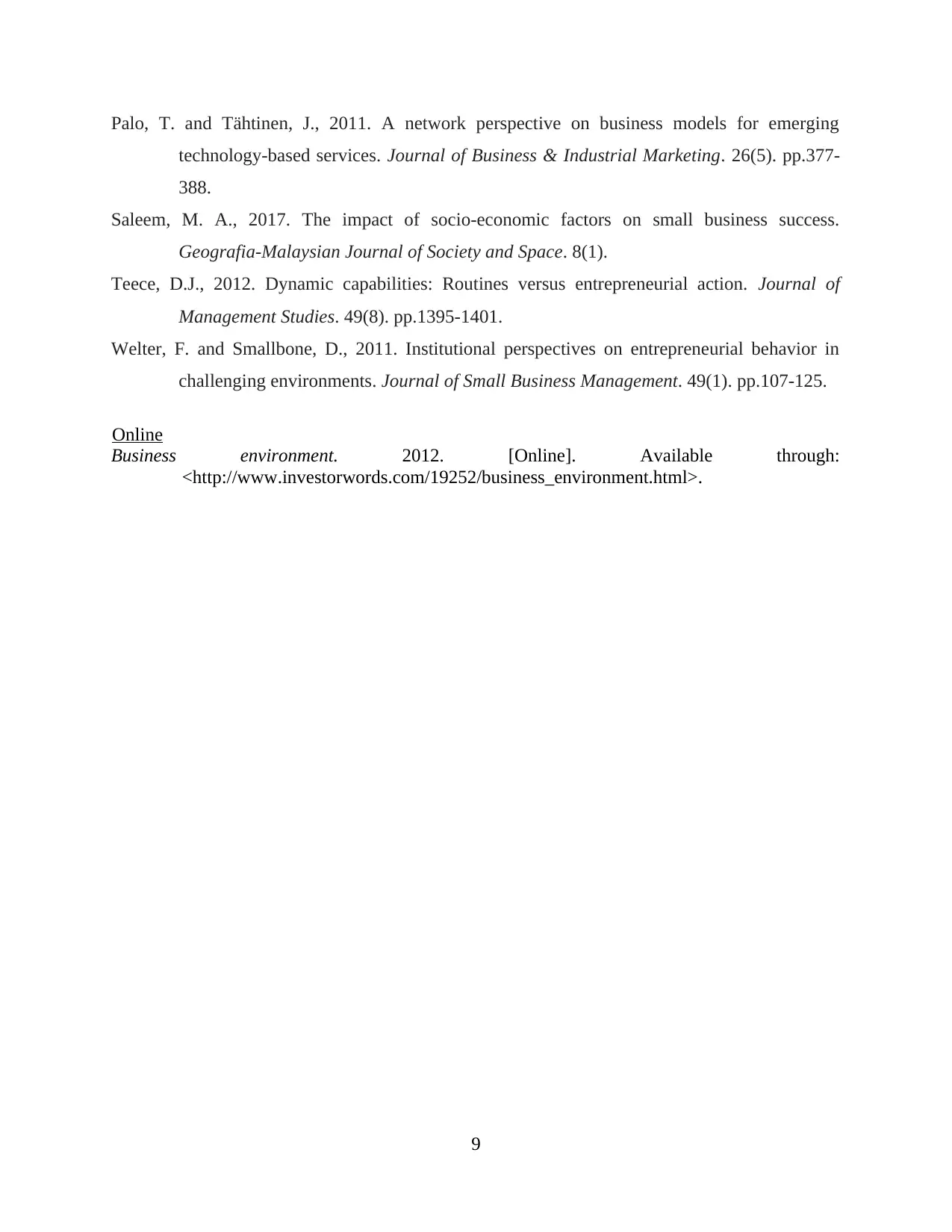
Palo, T. and Tähtinen, J., 2011. A network perspective on business models for emerging
technology-based services. Journal of Business & Industrial Marketing. 26(5). pp.377-
388.
Saleem, M. A., 2017. The impact of socio-economic factors on small business success.
Geografia-Malaysian Journal of Society and Space. 8(1).
Teece, D.J., 2012. Dynamic capabilities: Routines versus entrepreneurial action. Journal of
Management Studies. 49(8). pp.1395-1401.
Welter, F. and Smallbone, D., 2011. Institutional perspectives on entrepreneurial behavior in
challenging environments. Journal of Small Business Management. 49(1). pp.107-125.
Online
Business environment. 2012. [Online]. Available through:
<http://www.investorwords.com/19252/business_environment.html>.
9
technology-based services. Journal of Business & Industrial Marketing. 26(5). pp.377-
388.
Saleem, M. A., 2017. The impact of socio-economic factors on small business success.
Geografia-Malaysian Journal of Society and Space. 8(1).
Teece, D.J., 2012. Dynamic capabilities: Routines versus entrepreneurial action. Journal of
Management Studies. 49(8). pp.1395-1401.
Welter, F. and Smallbone, D., 2011. Institutional perspectives on entrepreneurial behavior in
challenging environments. Journal of Small Business Management. 49(1). pp.107-125.
Online
Business environment. 2012. [Online]. Available through:
<http://www.investorwords.com/19252/business_environment.html>.
9
⊘ This is a preview!⊘
Do you want full access?
Subscribe today to unlock all pages.

Trusted by 1+ million students worldwide
1 out of 12
Related Documents
Your All-in-One AI-Powered Toolkit for Academic Success.
+13062052269
info@desklib.com
Available 24*7 on WhatsApp / Email
![[object Object]](/_next/static/media/star-bottom.7253800d.svg)
Unlock your academic potential
Copyright © 2020–2025 A2Z Services. All Rights Reserved. Developed and managed by ZUCOL.





